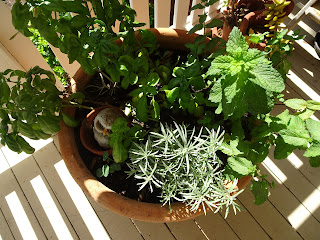Hello
Our Peace rose is blooming again...
During the extreme heat, we have been giving extra buckets of grey water to the roses, augmenting the light hosing they receive a few time a week.
It has paid off, and the roses are making a big effort...
 |
| Claude Monet, France 1840-1926: Nympheas [Waterlilies] c.1914-17. National Gallery of Australia |
A beautiful Monet has come to visit us in Brisbane.
Impressionist painter Claude Monet is one of the most popular painters who ever lived. Many of you will have travelled to the village of Giverny, north of Paris, where he painted his exquisite, atmospheric and immersive waterlily paintings between 1897 and 1926. The garden with its distinctive Japanese bridge can be visited to this day.
On loan from the National Gallery of Australia, Canberra, Nympheas belongs to the later period of his work.
In the foreground, edging the pond, we see the intense blue, green and yellow of a bed of irises above a grassy verge.
Beyond that is a wonderful, misty mauve mass of waterlilies, floating in the pond and seemingly in the atmosphere.
The painting is large, 201 cm wide and 181 cm high.
It remained with Monet until his death in 1926, then with his son Michel until 1960 after which it was sold to New York, and then to the Australian National Gallery in 1979.
It will be on exhibition at the Qld Art Gallery for several months.
Don't miss it!
A series of very different, but equally beautiful, waterlilies can also be found in the Gallery. They are part of an exhibition entitled 'Dyinala, Nganinya', unique sculptural pieces by Indigenous Queensland artist, Shirley Macnamara.
 |
| Shirley Macnamara 'Nhugu - Waterlilies' 2019. |
Macnamara lives and works on her cattle property in North West Queensland, and uses only materials from her own environment that retain the essence of the bush. In this case, she uses Spinifex, a native grass, ubiquitous around her home, a tough and resiliant plant which tolerates the hot, dry weather conditions.
She selects fine strands to use, stripping off their dull outer casing to reveal the glowing yellow, gold and red inner colours. Wearing gloves to protect her hands from the tough fibres, she intertwines, tucks and stitches, and glues the grass into position to create forms.
When Macnamara was born in 1949, she received her customary Dreaming identity. She was 'signed' for Kudaanh.nyirri, the keeper of waterhole lilies. She was placed as a custodian of the upper Georgina River lakes and waterholes, in the Mt Isa region of Queensland.
 |
Shirley Macnamara 'Spinifex vessel, coolamon; 1998
|
 |
| Shirley Macnamara 'Guutu (vessel)' 2001: Spinifex, emu feathers. |
While we are talking about the Australian bush, here is some recent action in our Red Cardinal personal gum tree last week.
We were woken early by a cacophony of birdsound - lots of birds, shrieking, calling and generally awakening the whole neighbourhood.
After several hours of this nonsense, I started looking carefully (from the safety of our deck) up and down our various trees and plants, and then I spotted it:
That big dark lump is a bush python, rolled up sleeping after a heavy meal.
Can you see the cockatoo on the top left of the picture?
Two of them were trying to scare off the snake by snapping off bits of branches and attempting to throw them at it.
It did not work, they simply littered the ground below.
But isn't nature wonderful? They made a valiant effort to fight the 'enemy'.
The enemy however ignored the noise, which went on and off all day as new arrivals flew in to shriek their horror.
Mr Cardinal snapped this picture with a Very Strong telescopic camera.
These snakes are nocturnal, and during the night it quietly slipped away.
At least, we think it has gone.....
Thank heavens for good strong security screens.
Have a good week.
XXXXX
.















































